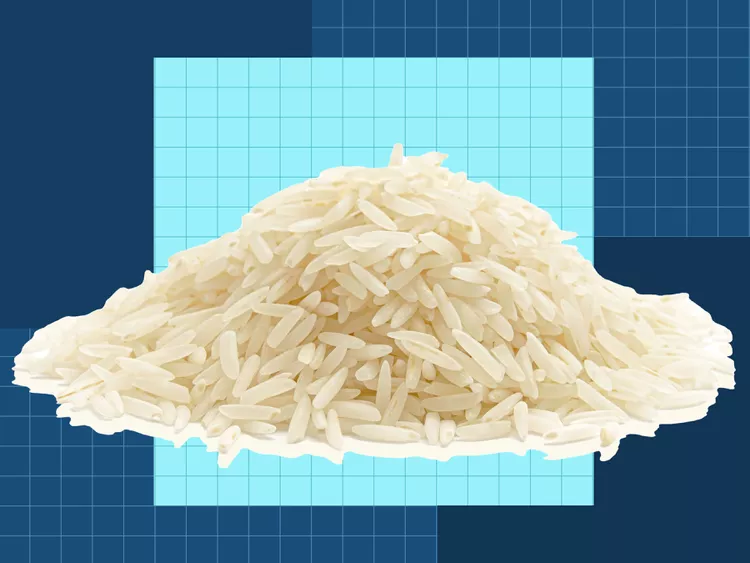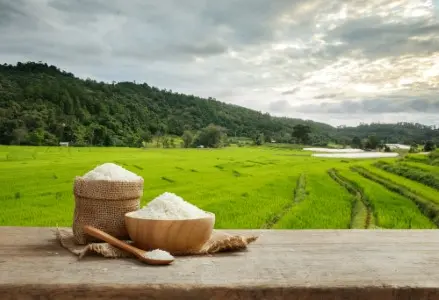Tags
What Is Basmati Rice? A Guide to What Some Call the “Queen of Rice”
This fragrant, tender, fluffy rice variety is cherished across South Asia and the Middle East.
By Perry Santanachote

Basmati rice—often called the “queen of rice” in India and Pakistan—is cherished in kitchens worldwide, particularly in South Asian cuisines. When translated directly from Hindi, basmati means “queen of fragrance.” Its delicate aroma, long slender grains, and fluffy texture make it a favorite in various dishes. “Growing up as a first-generation Indian, we never ate a meal without rice,” says Priyanka Naik, a chef, TV host, columnist, and author of The Modern Tiffin. “Whether it’s just plain rice or made into a pulao, basmati is a huge part of our diet, and we’re very particular about how it’s cooked.”
Whether you’re preparing a traditional biryani or a simple side of steamed rice for curry or dal, understanding how basmati rice is cultivated, selected, and cooked can elevate your culinary game. We spoke with Naik, as well as Brita Lundberg, a fourth-generation farmer at the California-based rice farm Lundberg Family Farms to learn more.
How Basmati Rice Is Cultivated
Basmati is a long-grain rice variety developed at least 250 years ago by the farmers of India and Pakistan and grown along the Himalayan foothills in these two countries ever since. The unique environment of the area, with its cool climate and nutrient-rich soil, plays a significant role in developing basmati’s subtly nutty flavor and aroma that’s reminiscent of pandan and popcorn. Growing basmati rice is truly an art form. Farmers in India and Pakistan grow seedlings in a nursery and then transplant them by hand. The process requires careful attention to detail to ensure the grains develop their characteristic length, aroma, and texture. After harvesting, Indian and Pakistani basmati undergoes a period of aging through long storage, typically for six months to a year, which intensifies the flavor and allows the grains to elongate further when cooked.
What About American-Grown Basmati?
Because of the unique environment in India, Pakistan, and other parts of the Indian subcontinent, which contributes to basmati’s unique flavor and aroma, true basmati can’t be grown in the US—but since there are currently no patents or official DOP- or DOC-style rules (designation of origin) rules governing basmati there have been cases in the States of companies creating basmati hybrids without acknowledging the rice’s South Asian history. Most notably, in 1984, Robin Andrews, former chief executive of the rice company RiceTec, created a hybrid between basmati and American long-grain rice and marketed it as Texmati. It’s still sold today, along with other American hybrids, and has been the topic of much discussion surrounding colonialism and imperialism. These hybrids are grown by planting seeds directly into production fields, instead of in a nursery. Similarly, Lundberg Family Farms grows a version of basmati in California and calls it “California basmati” to distinguish it from basmatis grown in the Indian subcontinent. Unlike Indian basmati, the grains of American basmatis usually don’t elongate during the cooking process and they tend to have a less pronounced aroma.
How to Shop for Basmati Rice
:max_bytes(150000):strip_icc():format(webp)/GettyImages-1186262899-e4c4d6f822ec47cf9d26841c3c8453a3.jpg)
When shopping for basmati rice, the packaging and the grain itself can tell you a lot about its quality. Here’s what to look out for:
Grades and Terminology
There are a few terms and grades you will encounter when shopping for basmati rice.
- Super basmati is the top grade, featuring extra-long, slender grains. It’s ideal for special dishes like biryani or pilaf.
- Pusa basmati is a hybrid version of basmati rice that also has long grains but is typically less expensive than super basmati.
- Brown basmati retains the bran layer, offering more fiber and nutrients than white basmati, but with a nuttier flavor and chewier texture.
- Aged basmati is rice that’s undergone the aging process, which gives it a stronger flavor and fluffier texture.
Grain Appearance
A good basmati rice grain should range from long (6.6 to 7.5 mm) to very long (more than 7.5 mm) and be slender (2 mm wide). Broken or short grains indicate lower quality. “Look for translucent—not chalky—grains of uniform shape and size to ensure a consistent cook and ideal texture,” says Lundberg. The color should be slightly off-white or light golden due to the aging process. If the rice looks too white, it might have been over-processed or over-polished.
Storage
Keep dry basmati rice in an airtight container in a cool, dry place away from direct sunlight, along with the moisture-absorbing packet that typically comes with the rice to help keep it fresh. If it’s especially humid where you live, or you’re concerned about pests, keep your rice in the freezer, which shouldn’t affect its quality.
Signs of Well-Cooked Basmati Rice
Indian and Pakistani basmati grains should lengthen significantly when cooked—almost double their original length. “There’s no right or wrong way to cook it,” says Naik. “It depends on your personal preferences and what dish you’re eating it with.” You can cook the rice on the stovetop or in a rice cooker, but note that the grains may not be as fluffy when made in a rice cooker.
If you’re eating rice with something soupy like dal (stewed lentils), Naik says the rice should be cooked with slightly more water than the typical 1:1 ratio she recommends so it comes out a bit mushy, because once you pour the dal over the rice, the rice needs to absorb it. If the rice grains are too loose, the rice won’t absorb the dal and instead will just spread out on your plate.
For specialty rice dishes, like pulao, each grain should remain distinct, not sticky or mushy. Sauté the washed grains first with nuts like pistachios, almonds, or cashews, and spices like peppercorns, a cinnamon stick, and turmeric. “This type of rice must be made in a wide pan, not in a pot, because you want all the rice grains to hit the heat and mix with the spices,” says Naik. Once the mixture is aromatic, add water (1:1.5 or 1:2 rice to water ratio) and bring it to a simmer. Cover and cook until it’s a loose and fluffy consistency with a slightly al dente bite, about 15 minutes.
Common Uses for Basmati Rice
Basmati rice is incredibly versatile. Its light, fluffy texture pairs beautifully with everything from rich spiced meats to delicate vegetable stews. Aside from South Asian dishes, it also is just as prized in Middle Eastern cuisines. Here are some of the most popular uses:
Steamed: A simple side of steamed basmati rice is often served with curries, kebabs, and grilled vegetables across many cuisines. Its light and fluffy texture balances out the richness of many accompanying dishes. For a variation on plain steamed rice, try Persian-style chelow.
Biryani: Perhaps one of the most famous dishes using basmati rice, biryani is a rich layered rice dish cooked with spices, vegetables, and meats like chicken or lamb. The long grains of basmati are perfect for absorbing the complex flavors of this dish.
Pilaf: Basmati rice is often used in pilafs, where it’s cooked with fragrant spices, broth, and sometimes dried fruits or nuts. The rice’s fluffy texture and the grains’ ability to stay separate make it ideal for this type of dish. Take your pick from Greek, Armenian, and Indian styles, among others.
Desserts: In Indian and Pakistani cuisine, basmati is sometimes used in sweet applications like phirni, a creamy dessert commonly served during Muslim festivals in India. Dry fruits add texture to the base and you can add your favorite fruit pulp for extra flavor. Kheer—a silky rice pudding flavored with cardamom, saffron, and nuts—is also a popular South Asian dessert.
Dosa: These giant, crispy South Asian crepes are made from fermented basmati rice and lentils and usually served with chutney and sambar, or rolled like a wrap.
Tahdig: To make Persian tahdig, basmati is infused with saffron, cooked until crunchy, and bejeweled with pomegranate seeds. It’s often a centerpiece dish served with all kinds of entrées like stews, grilled or roasted meats, fish, vegetables, and herb platters.
The Takeaway
As you can see, basmati rice is more than just a side dish; it’s a staple ingredient that brings elegance and flavor to any meal. Understanding basmati rice is about appreciating the artistry behind it—from the field to the kitchen. When you select a good quality rice and cook it properly, the results are nothing short of extraordinary.
https://www.seriouseats.com/what-is-basmati-rice-8726575Published Date: October 11, 2024






